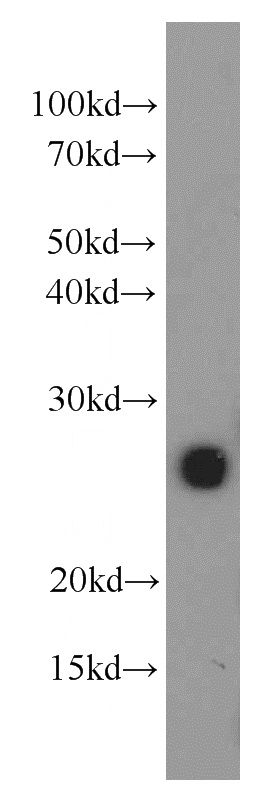-
Product Name
MOG antibody
- Documents
-
Description
MOG Rabbit Polyclonal antibody. Positive WB detected in mouse brain tissue. Observed molecular weight by Western-blot: 28 kDa
-
Tested applications
ELISA, WB
-
Species reactivity
Human,Mouse,Rat; other species not tested.
-
Alternative names
MOG antibody; MOGIG 2 antibody; myelin oligodendrOCyte glycoprotein antibody
-
Isotype
Rabbit IgG
-
Preparation
This antibody was obtained by immunization of MOG recombinant protein (Accession Number: XM_005249131). Purification method: Antigen affinity purified.
-
Clonality
Polyclonal
-
Formulation
PBS with 0.02% sodium azide and 50% glycerol pH 7.3.
-
Storage instructions
Store at -20℃. DO NOT ALIQUOT
-
Applications
Recommended Dilution:
WB: 1:200-1:2000
-
Validations

mouse brain tissue were subjected to SDS PAGE followed by western blot with Catalog No:112728(MOG antibody) at dilution of 1:500
-
Background
Myelin/oligodendrocyte glycoprotein (MOG), a 26-to 28-kDa glycoprotein, a myelin antigen at the outer surface of the central nervous system (CNS) myelin sheath, which may trigger T-cell as well as B-cell responses. It therefore constitutes a pivotal target for autoimmune responses, which result in inflammation and also demyelination in the CNS. Its presence on the outer- most lamellae of mature CNS myelin and its late appearance during myelinogenesis suggest that it contributes to myelin maturation or maintenance. 10 isoforms of MOG produced by alternative splicing have been described, and heterodimers may be formed between the different isoforms. Defects in MOG are the cause of narcolepsy type 7 (NRCLP7), a neurological disabling sleep disorder characterized by excessive daytime sleepiness, sleep fragmentation, symptoms of abnormal rapid-eye-movement (REM) sleep, cataplexy, hypnagogic hallucinations, and sleep paralysis. Role of MOG in the pathogenesis of multiple sclerosis (MS) has been reported but remains to be clarified.
-
References
- Cong H, Jiang Y, Tien P. Identification of the myelin oligodendrocyte glycoprotein as a cellular receptor for rubella virus. Journal of virology. 85(21):11038-47. 2011.
- Kuronen M, Hermansson M, Manninen O. Galactolipid deficiency in the early pathogenesis of neuronal ceroid lipofuscinosis model Cln8mnd : implications to delayed myelination and oligodendrocyte maturation. Neuropathology and applied neurobiology. 38(5):471-86. 2012.
Related Products / Services
Please note: All products are "FOR RESEARCH USE ONLY AND ARE NOT INTENDED FOR DIAGNOSTIC OR THERAPEUTIC USE"
